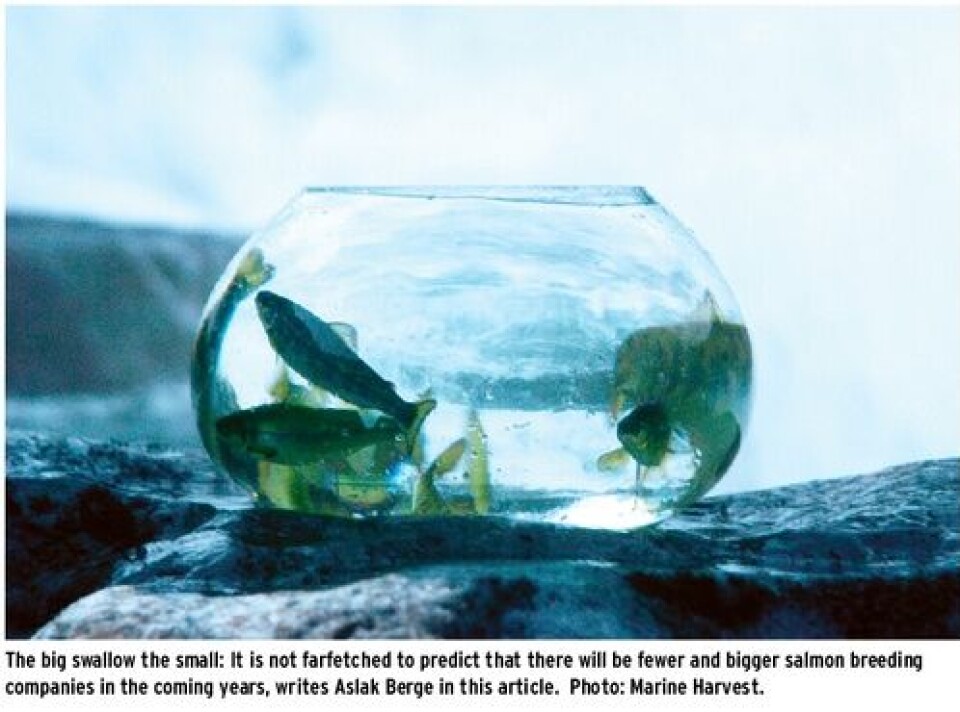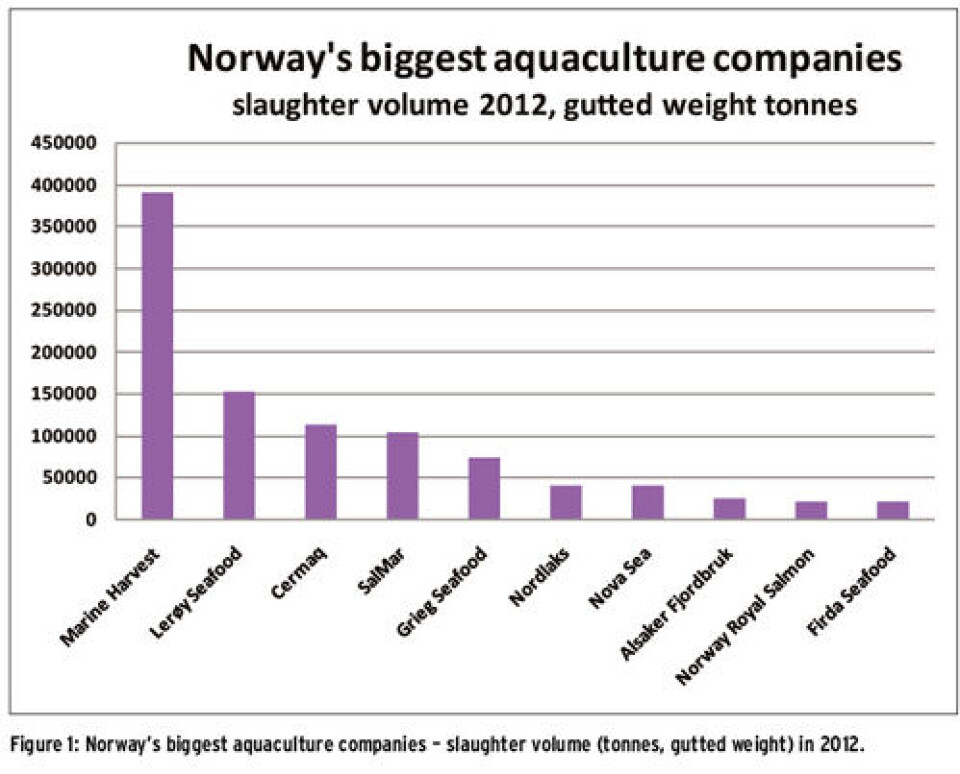Relaxation of rules of ownership opens for the big fish
Posted by Aslak Berge. Berge works as an independent consultant, and has many years of experience as an equity analyst and financial journalist.

Just before Christmas, the department of Fisheries announced, somewhat reluctantly, that they will relax the ownership restrictions in Norwegian aquaculture from the current maximum 25 percent ownership of the outstanding licenses for salmon and trout. This restriction has, until now, only been relevant for one company: Marine Harvest. Of course, Marine Harvest’s CEO, Alf Helge Aarskog, applauded the decision as ‘a wise decision’. It is no secret that Aarskog and Marine Harvest have put quite some pressure on the department to get this decision to be realized.
Quick response With the relaxed ownership regulation, Aarskog & Co acted immediately. Five days after the announcement, he put 938 million NOK on the table in order to acquire 48.5% of the shares in the world’s leading processing business for salmon, the Polish giant smoking plant Morpol. Nine years after shutting down their processing plants in Norway, acquiring a loss of 350 million NOK, Marine Harves is again heavily involved in processing. In addition, Marine Harvest is acquiring Morpol’s aquaculture facilities, mostly Jøkelfjord’s and Marine Farm’s licenses, which, in total, slaughtered 30.000 tonnes of salmon in 2012. And precisely the acquisition of old Jøkelsfjod’s food fish license in Finmark is interesting. It is not improbable that this is a notice about that especially Marine Harvest, but also other big actors in the industry, will challenge the rules of ownership even more – and secure and an even bigger share of the licenses in Norway. Ownership causing trouble A limit for licenses has existed for a long time. It was introduced in response to the big wave of consolidations that followed after the ‘one man, one license’ principle was lifted in 1991. A long line of fusions and license acquisitions concentrated the aquculture industry, which previously had been very fragmented, around only a few actors during the 1990s.
The question of ownership only really became a problem when Hydro Seafood was bought by Nutreco in 2000. The sale of the Norwegian flagship to a foreign multinational company was a bitter pill to swallow – not least for a couple of politicians in Parliament. Here, relocation of both ownership and farming were discussed. In the following hysteria, some of the national politicians forgot that Norway’s unique geographical and climatic conditions for salmon breeding were not threatened by scary foreign investors. Neither were the tax incomes for the government. However, decision making power and the so-called corporate and financial upside were in foreign hands. EEA dictate Historically, Norway has not had – and still hasn’t – very much private capital. And the limited private corporate environments have often felt that they were treated badly by the shifting social democratic governments. Thus, the elected politicians have chosen to regulate ownership – either through license regulations or through the ownership-regulation. But this has to be done in agreement with the framework that Norway is committed to through the EEA agreement. This also includes the four liberties – free exchange of goods, services, labour force and capital. And the last of these has failed in this instance.
At the turn of the millennium, the maximum allowed ownership was set at a limit of 20% of Norway’s total licenses. This was challenged Hydro Seafood/Marine Harvest- owner at the time, Netherland’s Nutreco. Nutreco’s CEO, Wout Dekker, made it clear once and for all that they were not pleased with a limit on growth in the leading salmon producing country. In the spring of 2006, Nutreco sold their shares in Marine Harvest and salmon farming – to shipowner John Fredriksen. Fredriksen has also said repeatedly, through his side kick Tor Olav Trøim, that he thinks the special Norwegian ownership rules to be competitively disadvantageous and a clamp around the foot.

Lex Marine Harvest Altogether, Norway has at the moment about 900 food fish licenses. 25% of these are about 225 licenses. It is only Marine Harvest who has more than 200 licenses. Number two, Lerøy Seafood Group, has only about half that amount (Fig.1). Lerøy’s management has announced earlier that they want to challenge the ownership rules. This means that they are considering fusions or acquisitions that could double their production capacity. The five biggest license holders are all represented in other salmon producing countries, but all of them have Norway as their most important, biggest and in time most profitable country for production.
The ownership rules have their origin in a more or less rational fear that a foreigner, perhaps a shipowner from Cyprus, could buy the whole industry and put up McDonald’s signs on all aquaculture farms. The Norwegian aquaculture has its origin in local ownership and local fish farmers’ initiative. It is a rare industrial fairy tale combined with rural development. And in addition, the products are some of the healthiest thing a man can eat. The thought of some greedy capitalists from other countries and industries taking over the industry when it finally gets profitable, is enough to give most of the smaller fish farmers the shivers. Then it doesn’t take long before they start complaining to the authorities. The ownership regulations in aquaculture have parallels in the fisheries regulations (participant’s rule). Other countries with aquaculture, like e.g. the Faroes, have comparable restrictions for ownership of the countries’ aquaculture activities. Several roads to Rome On the opposite side of the scale for ownership rules one can find the world’s largest fishery, the Peruvian anchovy fishery. Here the ownership rules are altogether liberalised. This means that one owner could, in theory, control all catch quotas. However, and this is the crucial point, this owner is not allowed to act monopolistic. It is not necessarily so that a dominating foreign owner will act irrationally. On the other hand, it is definitely comforting not having to worry about becoming a crofter along your own coast.
The stock analysists following Marine Harvest and the other big, listed salmon breeding companies were not dissatisfied with the decision from the department of Fisheries. They are especially pointing out the increased possibilities for fusions and acquisitions – not surprisingly, since this can lead to more money in the pockets of the brokers.
- Most of the bigger, listed salmon breeders have reached or are getting closer to their maximum capacity. Since issuing of new licenses and/or increased MTB is expected to be relatively restricted, fusions and acquisitions will be an important part of the growth strategy for most of these companies, as analyst Henning Steffenrud at Swedbank First Securities writes in a note to his customers in connection to the decision of the department of Fisheries. Renaissance of dreams Fish analysits have put away the most spectacular salmon fusions during the past years, because restrictions of ownership have stopped them. Without these restrictions, they can now brush off the dust of plans for gigantic fusions (and the associated consultant fees).
Slacking of the ownership rules has also made it easier to acquire even the biggest companies. It is not impossible that this might be one of the reasons for the increase in share prices of some of the biggest actors over the past month. This is especially true for those that, in theory, might be considered potential targets for acquisition by Marine Harvest. Since the middle of December the shareholders of Cermaq (+8,6%), Lerøy Seafood Group (+9,4%), Grieg Seafood (+8,8%), SalMar (+12,2%) have all seen their market values rise. After a period of new listing of aquaculture companies on the Oslo stock exchange, the optimists are now hoping for a time of mutual acquisition. This, at least, is what the brokers/consultants are hoping for. Sharks Marine Harvest’s rich uncle, John Fredriksen, is characterized as an aggressive consolidator in the industries he is engaged in - oil rigs, large tankers and dry bulk. The acuquisition of Marine Harvest and fusion with Pan Fish and Fjord Seafood in 2006 was a proof of that also in this industry. The drive for any further acquisitions has stopped, not least because of the mentioned ownership restrictions. Team Fredriksen/Trøim have pointed out, quite upset, that the only place where Marine Harvest has had the possibility to expand has been Chile – and there it has not been interesting because of the serious biological risk in that country. Marine Harvest has a considerable, latent production capacity in Chile. With a relaxation of the ownership rules, there is a good chance that the corporate departments of the brokerages may have more to do in the fish farming sector. Fewer and bigger After the establishment of the ‘new’ Marine Harvest in 2006, the wave of acquisitions in the Norwegian aquaculture has decreased. It does not seem that a relaxation of the ownership rules will result in a new era of acquisitions and fusions. Still, it is not farfetched to predict that there will be fewer and bigger salmon breeding companies in the coming years.






















































